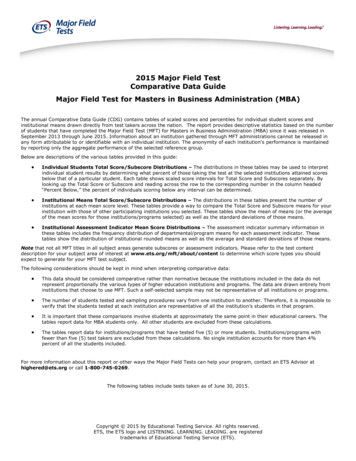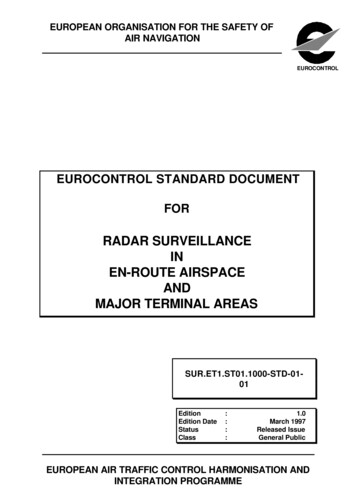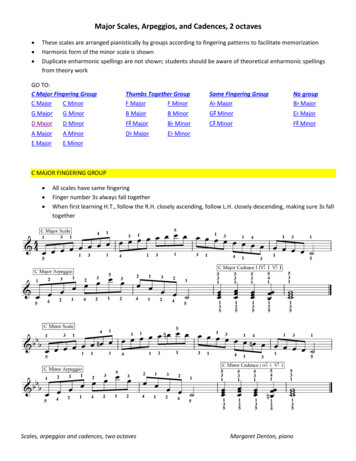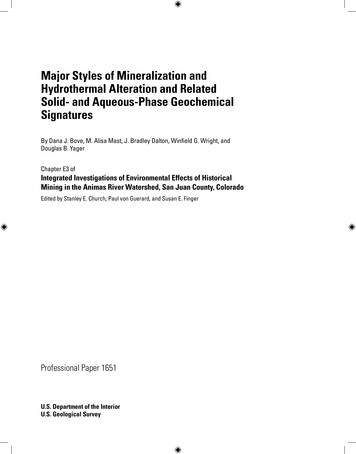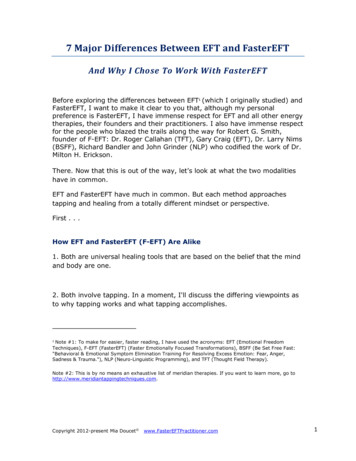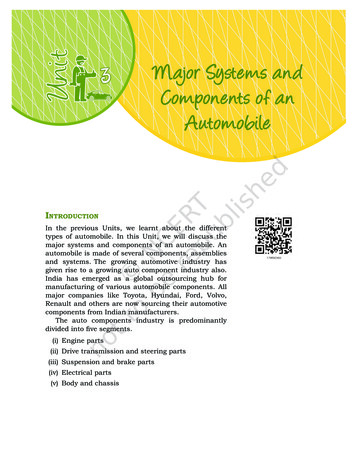
Transcription
Unit3Major Systems andComponents of anAutomobileIntroductionIn the previous Units, we learnt about the differenttypes of automobile. In this Unit, we will discuss themajor systems and components of an automobile. Anautomobile is made of several components, assembliesand systems. The growing automotive industry hasgiven rise to a growing auto component industry also.India has emerged as a global outsourcing hub formanufacturing of various automobile components. Allmajor companies like Toyota, Hyundai, Ford, Volvo,Renault and others are now sourcing their automotivecomponents from Indian manufacturers.The auto components industry is predominantlydivided into five segments.(i) Engine parts(ii) Drive transmission and steering parts(iii) Suspension and brake parts(iv) Electrical parts(v) Body and chassisUnit 3.indd 393/11/2021 12:02:18 PM
Global automobile manufacturers see India as amanufacturing hub for auto components due to thefollowing reasons:(i) Low-cost labour force and availability of rawmaterial which makes India cost competitive(ii) An established manufacturing base in India(iii) Setting up of the operations of major internationalauto components including Delphi, Visteon, Boschand Meritor in India(iv) Setting up of International Purchasing Offices(IPOs) of automobile manufacturers and autocomponent manufacturers in India(v) Fine-quality components manufactured in India(vi) India being a global hub for research anddevelopment (R&D), General Motors, DiamlerChrysler, Bosch, Suzuki, Johnson Controls, etc.,have their research centres in IndiaIn this Unit, you will learn about the variouscomponents and systems that make a completeautomobile—the engine and its parts, the bodyand chassis, drive transmission and steering parts,suspension and brake parts, electrical parts and othersystems that make running an automobile possible.Session 1: ChassisandAuto BodyChassisFig. 3.1: Chassis with suspensionand exhaust system40Unit 3.indd 40Chassis is a French term and was initially used todenote the frame or main structure of a vehicle. Thechassis (Fig. 3.1) contains all the major units necessaryto propel the vehicle, guide its motion, stop it andallow it to run smoothly over uneven surfaces. It isthe main mounting for all the components includingthe body. It is also known as the carrying unit.The chassis includes the following majorcomponents.(i) A steel frame, which is a major part.(ii) In case of a passenger car, the whole body isalso an integral part of the chassis. However, incommercial vehicles like trucks and buses, thebody is not a part of the chassis. Therefore, achassis is almost a complete vehicle except theAutomotive Service Technician – Class IX13-Mar-19 3:07:40 PM
body and other accessories, which are not involvedin the movement of the vehicle.(iii) Other major components include engine,transmission system, front and rear axle, steeringsystem, suspension system, wheels, tyresand brakes.Functions of the chassisThe functions of the chassis includes(i) carrying the weight of the vehicle and its passengers,(ii) withstanding the engine and transmission torqueand thrust stresses, as well as accelerating andbraking torque,(iii) withstanding the centrifugal force while taking aturn and(iv) withstanding the bending load and twisting due tothe rise and fall of the front and rear axles.Automobile Body or SuperstructureIn case of integral or frameless construction, the body is anintegral part of the chassis. But, in case of the conventionalchassis, the body or superstructure is made after receivingthe chassis from the manufacturer. The shape of the bodydepends upon the ultimate use for which the vehicleis meant.The body of a car (Fig. 3.2) is made of a sheet of metalor fibre glass, so that passengers can sit in it. To makeFig. 3.2: Body of a carMajor SystemsUnit 3.indd 41andComponentsof anAutomobile4129-Mar-19 12:32:49 PM
the journey comfortable, cushioned seats are provided.The body is provided on all sides with glass panes fixedto protect the passengers from dust and rain.The body of a bus is made of metal, like(a) steel section pillars with steel sheet panelling,(b) steel section pillars with aluminium panelling and(c) all aluminium bodies, i.e., pillars, frameworkand panelling made of aluminium sections andsheets. This is because aluminium is very light inweight compared to steel.The body of a truck has the driver’s compartmentcovered and the rest is kept open. Such bodies areusually called load bodies. In most of the cases, it is anopen body, whereas for liquid material like water, milkand fuel products, a tank is mounted on the chassis.The body is fixed to the chassis with the help of I- orU-bolts with rubber packing placed between the chassisand body cross members.Requirements of automobile bodyThe body of a motor vehicle should fulfill certainrequirements. It should(i) be light weight.(ii) have minimum number of components.(iii) have long fatigue life.(iv) have uniformly distributed load.(v) have sufficient space for passengers and luggage.(vi) have good access to the engine and suspension system.(vii) have minimum vibrations when the vehicle is running.(viii) have minimum resistance to air.(ix) be cheap and easy in manufacturing.(x) have clear all-round vision through glass areas.(xi) have an attractive shape and colour.Check Your ProgressA. Fill in the blanks1. A chassis is almost a complete mounting body.2. The shape of the chassis depends upon the ultimateuse of the .42Unit 3.indd 42Automotive Service Technician – Class IX29-Mar-19 12:32:49 PM
3. Major part of a chassis is the frame.4. In commercial vehicles like trucks and buses the body isnot a of the chassis.5. In most of the cases, it is an open body, whereas for liquidmaterial like water, milk and fuel a is mountedon the chassis.B. Multiple choice questions1. Chassis is a French term and was initially used to denote.(a) main structure of a vehicle(b) fixing the automobile body(c) transmission system, front and rear axle(d) carrying the bolt2. What are the functions of the chassis frame?(a)(b)(c)(d)To carry the weight of the vehicle and its passengers.To withstand the engine and transmission torque.To withstand the centrifugal force while cornering.All of the above3. Automobile body is made of .(a) sheet metal or fibre glass(b) iron(c) copper(d) gun metal4. The body is fixed to the chassis with the help of.(a) I or U bolts(b) rivet(c) welding(d) threaded bolt5. Automobile body should fulfill which of the followingrequirements?(a) The body should be light.(b) It should have a long fatigue life.(c) Both (a) and (b)(d) None of the aboveC. Short answer questions1. Differentiate between chassis frame and automobile body.2. Explain the use of the chassis frame.3. How does auto body help in transport?Major SystemsUnit 3.indd 43andComponentsof anAutomobile4329-Mar-19 12:32:49 PM
Session 2: EngineandIts ComponentsAn engine (Fig. 3.3) is complex unit in which differentcomponents are assembled together, and fuel is burnedto produce power or energy. The engineconverts chemical energy (heat energy)into mechanical energy, which isthen utilised for vehicular movement.There are different processes of fuelcombustion. When the fuel is burnedwithin the engine, it is called an InternalCombustion (IC) engine, and when it isburned externally and the producedsteam is used for the mechanicalmovement, it is called an ExternalCombustion (EC) engine. Nowadays,automobile engines are quite economicaldue to the developments taking place inthe field of internal combustion engine.Fig. 3.3: EngineOn the basis of the process of ignition,the automobile engines are classified into spark ignitionengine (petrol or gas) and compression ignition engine(diesel). In an IC engine, the reciprocating motion of thepiston is converted into rotary motion of the crankshaftand the produced power is then transmitted to movethe vehicle. In case of a rotary engine or Wankelengine, the rotor rotates and completes the process ofcombustion and produces the power, which helps thevehicular movement.The spark ignition engine can be differentiated from thecompression ignition engine as per the following factors.(i) The type of fuel used.(ii) The way the fuel enters in the combustion chamber.(iii) The way in which fuel is ignited.Spark Ignition Engine (Petrol or Gas Engine)The spark ignition engine uses a highly volatile fuel,such as gasoline, which turns into vapour easily. Thefuel is mixed with air before it enters in the combustionchamber, and forms a combustible air-fuel mixture.This mixture then enters the cylinder and gets44Unit 3.indd 44Automotive Service Technician – Class IX13-Mar-19 3:07:40 PM
compressed with the help of a piston. An electric sparkis produced by the ignition system which ignites thecombustible air-fuel mixture. The combustible gasesburn and expand, which forces the piston downwards forgenerating power.Compression Ignition Engine (Diesel Engine)In the compression ignition engine or diesel engine,only fresh air enters the cylinder, which is compressedto a very high pressure and temperature, which couldgo up to 1000 F (538 C). The diesel is then injected orsprayed into the engine combustion chamber. Thisspray contains very fine and tiny particles of diesel inan atomised form. The hot air or heat of compressionignites the fuel and generates the power stroke.Components of an IC Engine1. Cylinder: The cylinder or cylinder liner of an ICengine is fitted in the cylinder block, which is asingle casted unit and is considered to be the mainbody of an engine. The block has cylinder liners.The piston reciprocates up and down from TopDead Centre (TDC) to Bottom Dead Centre (BDC)to generate power.The cylinder liner and the cylinder block haveto withstand very high pressure (about 70 bar)and temperature (about 700 C) during powerstroke. The material used for the cylinder blockmust withstand such heat and also disperse iteffectively. The cylinder block is well-designedwith water passages to remove the excess heatand separate oil passages are provided for thecirculation of lubricating oil. The top portion of thecylinder block is covered by the cylinder head. Thecrankcase is an integral part of the cylinder blockwhich houses the crankshaft and the lower portionis dipped in an oil pan.Nowadays, cylinder liners are made of specialalloy and internal portion is coated with materiallike titanium which provides mirror finish and canwithstand the wear resistance. The upper end ofMajor SystemsUnit 3.indd 45andComponentsof anAutomobile4513-Mar-19 3:07:41 PM
the cylinder liner has a flange which fits well in thecylinder block. The exterior portion of the cylinderliner is exposed to water jacket for easy dispersionof heat.2. Cylinder Head: The cylinder head is also singlecasted unit and bolted to the top portion of the cylinderblock. The combustion chamber is a part of thecylinder head, where the combustion of gases takesplace. The water passages are provided to removethe heat from the cylinder head. In latest engines,the cylinder head also houses the camshaft whichhas the inlet and exhaust valves with supportivevalve mechanism. This provision is made to fix sparkplug in SI engines and nozzle in CI engines. Thelower portion of the cylinder head is well-machinedto ensure there is no leakage of gases. Cylinder headgasket is usually cast as one piece and bolted tothe top of the cylinder (engine block). Copper andasbestos gaskets are provided between the cylinderand cylinder‑head to obtain a gas‑tight joint. Thecharge enters the combustion chamber through theinlet valve connected to the inlet manifold, and theexhaust gases are removed through the exhaustvalves connected to the exhaust manifold.3. Piston and Piston Rings: Piston is a cylindrical unit,used to compress the charge during compressionstroke and to transmit the gas force to theconnecting rod and then to the crankshaft duringpower stroke. The pistons of IC engines are usuallymade of aluminium alloy, which has high thermalconductivity and is light in weight. The material ofpiston must have the ability for higher heat transfer.The piston moves up and down (from TDC to BDC)and assists in completing the engine cycle.The piston rings are placed in the ring grooveand provide sealing between the piston and thecylinder liner, thereby preventing the leakage of highpressure gases. These are made of special gradecast iron, which retains its elastic property even atvery high temperature. The upper piston rings arecalled the compression rings and the lower pistonrings are called the oiling or oil control rings.46Unit 3.indd 46Automotive Service Technician – Class IX13-Mar-19 3:07:41 PM
4. Connecting Rod: It is usually manufactured byusing drop-forged steel. It is made in the shapeof ‘I’ so as to reduce its weight and to withstandstrength. Its small end is connected to the pistonwith the help of gudgeon pin and the big end isconnected to the crankpin with shell bearings. Ithas a passage for the transfer of lubricating oilfrom the big end bearing to the small end bearing(gudgeon pin). The major function of the connectingrod is to convert the reciprocating motion of pistonto the rotary motion of the crankshaft.5. Crank and Crankshaft: The crankshaft (Fig. 3.4)is called the backbone of an engine because itconverts the reciprocating motion of piston into therotary motion of the crankshaft. The crankshaft is asingle casted unit and is made of drop-forged steelmain journals which are placed and supported inthe crank case. The main journal and connectingjournals are machined to a smooth finish to reduceCylinderPistonUPPiston PinDownBoltConnectingRodAround ina cricleCrank PinCrankshaftLower RodBearing CapWasterNutFig. 3.4: Crankshaft of multicylinder engineMajor SystemsUnit 3.indd 47andComponentsof anAutomobile4713-Mar-19 3:07:42 PM
friction and shell bearings are usedfor smooth rotation of crankshaft.Front end of the crankshaft willtransmit drive to the camshaft andalso to the timing gear, whereasthe flywheel is bolted to the flangeat rear end of the crankshaft.Snap ringMain journal of the crankshaftcarries the oil passages to lubricateshell bearings.In case of a single cylinderSnap ringengine crank assembly (Fig. 3.5) isused, two crank webs are connectedwith the crank pin, and crank websshafts are press fitted in both. Atone side of the shaft magneto isfastened whereas clutch assemblyFig. 3.5: Crank assembly of single cylinder engineis mounted to the other. The crankassembly is balanced dynamicallyas well as statically for the smooth transmissionof power.6. Piston Pin or Gudgeon Pin. This unit connectsthe piston and small end of the connecting rodand passes through the piston (Fig. 3.6). CirclipsPinExhaust camshaftCylinderheadCon RodIntake camshaftSparkplugExhaust ValveExhaustExhaust valveIntakeIntake valvePistonheadPiston pinInlet ValveConnectingrodEngine blockCylinderCrankshaftFig. 3.6: Important components of piston48Unit 3.indd 48Automotive Service Technician – Class IX13-Mar-19 3:07:42 PM
are fitted into recesses in the piston to preventthe gudgeon from touching the cylinder wall. Theneedle bearing or bronze bushing is press fittedinto the connecting rod, due to this the gudgeonpin provides bearing for the oscillating small endof the connecting rod.7. Inlet Valve: The major role of the inlet valve is tosubmit fresh charge in to the cylinder during thesuction stroke. Opening and closing of the valvewill control the admission of the charge into thepetrol engine or air into diesel engine duringsuction stroke of an engine. The valve operationswill be as per the valve timings. The inlet valve hasa wider face or in latest engines two inlet valves areused to maintain volumetric efficiency of an engine.8. Exhaust Valve: The exhaust valve removes outthe burnt gases from the combustion chamberafter power stroke. The exhaust valve has to baremore heat resistance.9. Valve Spring: The valve spring (Fig.3.7)plays an important role to closethe valve and also provides air tightcompartment to seal the combustiblegases during power stroke andalso maintain the self-centeringmovement of the valve. Both endsof the vale spring are machined forsmooth function and up and downmovements of the valves.Fig 3.7: Valve Spring10. Inlet Manifold: The fuel air mixtureis carried from the carburettor to the cylinderthrough a separate pipe through inlet manifold in acarbureted engine. Whereas in compression ignitionengines (diesel), the air is sucked through theinduction manifold. In M.P.F.I the engine holds thethrottle body on top of the manifold and the supplyof air is monitored by the throttle body sensor.11. Exhaust Manifold: It is a set of pipes and muffler,which is used to remove the exhaust gases fromthe exhaust ports. Engines oxygen sensors andcatalic convertors are used to reduce sound andair pollution, respectively (see Fig. 3.8).Major SystemsUnit 3.indd 49andComponentsof anAutomobile4913-Mar-19 3:07:42 PM
Air CleanerCarburettorIntake ManifoldExhaust ManifoldHeat ControlValve SpringFig. 3.8: Exhaust ManifoldFig. 3.9: Camshaft50Unit 3.indd 5012. Camshaft: The major function of the camshaft isto operate the intake and exhaust valves throughthe cam lobe, the gear drive transmits the powerfor the rotation of oil pump, therefore the oilpump sucks the oil from the oil sump and transitsthe same to the oil gallery. The camshaft (Fig. 3.9)is driven by crankshaft at half the speed ofthe crankshaft.13. Cam Lobe and Tappet: The cam lobe(see Fig. 3.10) of the camshaft is placed directlyabove the bucket tappet, such that the lobe comesaround it and pushes down the bucket tappet andthe valve, thus opening the valve. In an overheadcamshaft with rocker arm, the cam lobe comesunder the valve lifter, and causes the rocker armto rock or turn the lobe and pushes downthe valve steam and it moves down to open.When the cam lobe passes the valve lifterthe valve spring retains back to the originalAutomotive Service Technician – Class IX13-Mar-19 3:07:42 PM
length. To close the valve the rockerarm turns back and the valve lifter ispushed down on the cam. In case ofdouble overhead camshaft engine, thedouble row valves are usually operatedby the separate overhead camshaft.14. Push Rod and Rocker Arm: Themotion of the cam lobe pushes thevalve lifter upwards. This movementpushes the push rod (Fig. 3.11) and therocker turns the upward motion of thepush rod to the downward movement ofthe valve stem resulting in opening ofthe valve.Rocker ArmVariable cam timing acuatorOil pressure portsCam follower/lifterCam return springValveFig. 3.10: Cam Lobe and TappetValve Spring RetainerPush RodSpring ColletValve SpringCam FollowerCamValve GuideCamshaftValve StemValve HeadValve Seat InsertFig. 3.11: Push Rod and Rocker ArmMajor SystemsUnit 3.indd 51andComponentsof anAutomobile5113-Mar-19 3:07:43 PM
Fig. 3.12: Crank Case15. Crank Case: The crank case is an integratedpart of the cylinder block. The casing is providedto hold the crankshaft. The crankshaft is allowedto rotate freely and transmit the power to theflywheel (Fig. 3.12).16. Water Pump and Water Jacket: The function ofwater pump is to draw water from the radiatorand supply it to the water passages provided inFig. 3.13: Water Pump and JacketFig 3.14: Radiator52Unit 3.indd 52the cylinder block and cylinderhead with certain pressure. Thecirculation of coolant removes theexcessive heat from an engine.This helps in maintaining theengine temperature and also thelife of an engine (Fig. 3.13).17. Radiator: The major functionof the radiator is to radiatethe heat from the coolants. Ithas two tanks located at thetop and bottom. The uppertank is connected to the lowertank with the core through thepassages for easy radiationof the heat. The radiator alsostores the coolant (Fig. 3.14).Automotive Service Technician – Class IX13-Mar-19 3:07:43 PM
18. Flywheel: It is a wheel mounted on the crankshaftwhich stores the energy during the power strokeand transmits the energy to the transmissionsystem, the clutch and then to the gearbox (Fig. 3.15).Fig. 3.15: Fly wheel19. Governor: It is run by drive from the crankshaft.The function of the governor (Fig. 3.16) is toregulate the charge in case of petrol engine andFig. 3.16: GovernorMajor SystemsUnit 3.indd 53andComponentsof anAutomobile5313-Mar-19 3:07:43 PM
amount of fuel in case of diesel engine to maintainthe speed of the engine constant, when the loadrequirement varies.The components described above are commonly usedfor all types of IC engine. Here we are describing onlya few components which are used in particular typesof engines.20. Carburettor: The major function of the carburetor(Fig. 3.17) is to supply carburised fuel as perspeed and the engine load. In petrol engines thecarburettor is mounted on the induction pipe oron the induction manifold. The quantity of fuel airmixture in appropriate ratio is controlled by thethrottle valve and the movements of the throttlevalve are connected to the accelerator.Idle speed screwThrottle plateIdle mixture screwChoke plateClean airentersthroatFuel lineFuel filterFloatFloat bowlJetPedestalFig 3.17: Carburettor21. Spark Plug: The function of the spark plug is toignite the fuel air mixture after completion of thecompression stroke in an engine. It is generally54Unit 3.indd 54Automotive Service Technician – Class IX29-Mar-19 12:39:58 PM
placed in the combustion chamber of the cylinderhead. This is only used in petrol engine (Fig. 3.18).Terminal nutMetal ShellGround ElectrodeGasketHexagonCorrugationsThreadCentre Electrode(with copper core)InsulatorTop InsulatorInsulator NoseFig. 3.18: Spark Plug22. Fuel Injection Pump: In case of diesel engine thediesel oil from the fuel tank is sucked by the fuelfeed pump. The pump first sends the diesel oil tothe fuel filter and then to the transfer pump. Thetransfer pump increase the pressure of the fuel.Fig. 3.19: Fuel Injection PumpMajor SystemsUnit 3.indd 55andComponentsof anAutomobile5513-Mar-19 3:07:44 PM
The high pressure of fuel is then sent to the distributorrotor through the metering valve and from rotor thefuel is sent to the injector (Fig. 3.19). In case ofa multi point fuel injection system, the electric fuelpump is used and placed in the fuel tank. The pumpgenerates the injection pressure and sends it tothe fuel filter, and then to the common rail at apressure of 3 to 4 bar. The common rail or fuel railis connected to the fuel injector.23. Fuel Injector: The function of fuel injector(Fig. 3.20) is to break the fuel into fine spray(atomised condition) as it enters the combustionchamber of diesel engine.In case of an MPFI enginepetrol is injected at the end of compression strokeas the fine spray of the fuel burns more efficientlyin the combustion chamber giving better fuelefficiency with less air pollution.NippleOil outlet valveSpringOil outlet valve seatPump bodyTooth atainerAdjustingscrewRoller bodyRollerCamshaft bodyFig. 3.20: Fuel Injector56Unit 3.indd 56Automotive Service Technician – Class IX29-Mar-19 12:40:32 PM
Practical ExercisesActivity 1Name any five components of an automobile system used ina vehicle.S. No.Name of the system1.2.3.4.5.6.7.Check Your ProgressA. Fill in the blanks1. Engine is the of an automobile. Its role isvery important.2. Engine converts the Chemical Energy (heat energy) toEnergy.3. Major parts of engine are , ,and .4. The function of the carburettor is to supply uniformto the cylinder of a through theintake manifold.5. Sparkplug is used toB. Multiple choice questions1. The compression-ignition engine air is compressed so thatits temperature goes up to .(a)(b)(c)(d)538 C (1000 F) or higher348 C2480 CNone of the aboveMajor SystemsUnit 3.indd 57andComponentsof anAutomobile5713-Mar-19 3:07:45 PM
2. The cylinder of an IC engine is generally made of.(a) cast iron(b) copper(c) iron(d) fibre3. The charge (fuel and air mixture for SI engine and onlyair for CI engine) enters through the .(a) inlet valve(b) spark plug(c) outlet valve(d) piston4. The heart of the engine is the .(a) piston(b) cylinder head(c) connecting rod(d) All of the aboveC. Short answer questions1. Explain the role of engine and its components.2. Explain the difference between compression ignitionengine and spark ignition engine?Session 3: Lubrication SystemAs you know, our body requires fluids like water andalso oil in the form of fats like ghee, butter, cooking oilfor maintenance of our system. Similarly, lubricationis required for maintenance of engine. Lubricationsystem is one of the most important parts of an engine.The engine cannot run smoothly for more than a fewminutes without the lubricating oil.Whenever two metallic surfaces move over each otherunder direct contact, dry or solid friction is produced.This is due to the irregularities on the two surfacesinterlocking each other. The dry friction thus createdproduces a lot of heat and results in wear and tear ofthe metal surface.58Unit 3.indd 58Automotive Service Technician – Class IX13-Mar-19 3:07:45 PM
Objectives of LubricationThe main objectives of lubrication are(i) to reduce friction between moving parts to itsminimum value so that power loss is minimised, and(ii) to reduce wear and tear of the moving parts asmuch as possible.Apart from these objectives, lubrication also serves otherimportant purposes, which may be called secondary.These are as follows.(a) To provide cooling effect: The lubricating oiltakes heat from the hot moving parts during itscirculation and delivers it to the surrounding airthrough the crank case.(b) To provide cushioning effect: The lubricating oilalso serves as a good cushion against the shocksexperienced by the engine. For example, instantcombustion of the fuel in the combustion chamberproduces a sudden rise of pressure in the cylinderand the shock goes to the bearings through thepiston, gudgeon pin and the connecting rod. Thisshock is then absorbed by the layer of oil presentin the main bearings.(c) To provide cleaning action: The lubricating oil servesanother useful purpose of providing a cleaningaction. During its circulation, it carries away manyimpurities, such as carbon particles, etc.(d) To provide a sealing action: The lubricating oil alsohelps the piston rings in maintaining an effectiveseal against the high pressure gases in the cylinderthus preventing leakage towards the crank case.Practical ExercisesActivity 1List a few important functions of lubrication.S. No.1.2.3.4.Major SystemsUnit 3.indd 59Functions of lubricationandComponentsof anAutomobile5913-Mar-19 3:07:45 PM
Check Your ProgressA. Fill in the blanks1. Dry or solid friction is produced in .2. Dry friction creates lot of .3. The objective of lubrication is to reduce .4. Lubrication provides and effect.B. Multiple choice questions1. Viscosity is measured using a .(a) barometer(b) thermometer(c) viscometer(d) fathometer2. Lubricating oil is used for .(a) minimising wear in moving parts(b) help in keeping parts cool(c) Both (a) and (b)(d) None of the above3. Which type of lubrication system is used in a two-strokeengine?(a) petrol system(b) wet sump system(c) dry sump system(d) All of the above4. Viscosity index is a measure for the change of viscositywith change in .(a) pressure(b) temperature(c) volume(d) massC. Short answer questions1. Explain the importance of lubrication in engine.2. List the properties of lubricant.Session 4: Cooling SystemLike our body requires air and water for cooling our system,similarly the engine of a vehicle also requires cooling.The cooling system (Fig. 3.21(a-d)) has three primaryfunctions, which are as follows.(i) Remove excess heat from the engine(ii) Maintain a constant engine operating temperature(iii) Increase the temperature of a cold engine as quicklyas possible by maintaining the thermostat valve60Unit 3.indd 60Automotive Service Technician – Class IX13-Mar-19 3:07:45 PM
in a closed position which is fitted in the path ofcoolant circulation(a)(b)(c)(d)Fig. 3.21 (a–d): Cooling system of an engineNecessity of CoolingThe cylinders of internal combustion engines requirecooling because the engine cannot convert all the heatenergy released by combustion into useful work. Liquidcooling is employed in most of the IC engines, whetherthey are used in automobiles or elsewhere. The water(coolant) is circulated around the cylinders to pick upheat and then dissipate it through a radiator. As thetemperature increases from 71 to 82 degrees centigrade,the thermostat valve opens and sends water to theradiator to radiate the heat. When the temperature risesabove 82 degrees, the thermostat switch operates thecooling fan to support the cooling process in radiator.Major SystemsUnit 3.indd 61andComponentsof anAutomobile6113-Mar-19 3:07:45 PM
Practical ExercisesActivity 1List a few important functions of the cooling system.S. No.Functions of cooling system1.2.3.4.5.Check Your ProgressA. Fill in the blanks1. The cooling system removes excess fromthe engine.2. Cooling a constant engine operatingtemperature.3. The objective of cooling is to reduce .4. Liquid cooling is employed in most engines.B. Multiple choice question1. Which of the following type of cooling system is used in amotorcycle?(a) Air cooling system(b) Water cooling system(c) Both (a) and (b)(d) None of the above2. The cooling fan is .(a) driven by belt and pulleys(b) fitted between the engine and the radiator(c) driven from the camshaft(d) All of the above3. In water cooling, the water in the jac
and systems. The growing automotive industry has given rise to a growing auto component industry also. India has emerged as a global outsourcing hub for manufacturing of various automobile components. All major companies like Toyota, Hyundai, Ford, Volvo, Renault and others are now sourcing their
